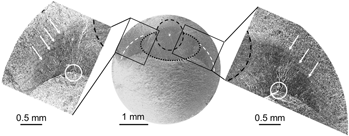Crossref Citations
This article has been cited by the following publications. This list is generated based on data provided by
Crossref.
Melnik, Yury A.
Kozochkin, Mikhail P.
Porvatov, Artur N.
and
Okunkova, Anna A.
2018.
On Adaptive Control for Electrical Discharge Machining Using Vibroacoustic Emission.
Technologies,
Vol. 6,
Issue. 4,
p.
96.
Seleznev, Mikhail
Wong, Ka Yiu
Stoyan, Dietrich
Weidner, Anja
and
Biermann, Horst
2018.
Cluster Detection of Non‐Metallic Inclusions in 42CrMo4 Steel.
steel research international,
Vol. 89,
Issue. 11,
Seleznev, M.
Gleinig, J.
Wong, K.Y.
Weidner, A.
and
Biermann, H.
2018.
Very high cycle fatigue behaviour of 42CrMo4 steel with plate-like alumina inclusions.
Procedia Structural Integrity,
Vol. 13,
Issue. ,
p.
2071.
Seleznev, M.
Merson, E.
Weidner, A.
and
Biermann, H.
2019.
Evaluation of very high cycle fatigue zones in 42CrMo4 steel with plate-like alumina inclusions.
International Journal of Fatigue,
Vol. 126,
Issue. ,
p.
258.
Seleznev, Mikhail
Henschel, Sebastian
Storti, Enrico
Aneziris, Christos G.
Krüger, Lutz
Weidner, Anja
and
Biermann, Horst
2020.
Effect of Filter Functional Coating on Detrimental Nonmetallic Inclusions in 42CrMo4 Steel and Its Resulting Mechanical Properties.
Advanced Engineering Materials,
Vol. 22,
Issue. 2,
Seleznev, Mikhail
Weidner, Anja
and
Biermann, Horst
2020.
On the formation of ridges and burnished debris along internal fatigue crack propagation in 42CrMo4 steel.
Fatigue & Fracture of Engineering Materials & Structures,
Vol. 43,
Issue. 7,
p.
1567.
Chung, Yu-Hsuan
Chen, Tai-Cheng
Lee, Hung-Bin
and
Tsay, Leu-Wen
2021.
Effect of Micro-Shot Peening on the Fatigue Performance of AISI 304 Stainless Steel.
Metals,
Vol. 11,
Issue. 9,
p.
1408.
Feng, Jian
Barth, Stefan
and
Wettlaufer, Marc
2021.
Symmetry Breakdown Related Fracture in 42CrMo4 Steel.
Metals,
Vol. 11,
Issue. 2,
p.
344.
Wang, Bing
Liu, Zhanqiang
Cai, Yukui
Luo, Xichun
Ma, Haifeng
Song, Qinghua
and
Xiong, Zhenhua
2021.
Advancements in material removal mechanism and surface integrity of high speed metal cutting: A review.
International Journal of Machine Tools and Manufacture,
Vol. 166,
Issue. ,
p.
103744.
Wagner, Ruben
Schmiedel, Alexander
Dudczig, Steffen
Aneziris, Christos G.
Volkova, Olena
Biermann, Horst
and
Weidner, Anja
2022.
Tailoring Nonmetallic Inclusions in 42CrMo4 as a Preparative Tool for Active and Reactive Steel Melt Filtration.
Advanced Engineering Materials,
Vol. 24,
Issue. 2,
Karimbaev, Ruslan M.
Cho, In Sik
Pyun, Young Sik
and
Amanov, Auezhan
2022.
Effect of Ultrasonic Nanocrystal Surface Modification Treatment at Room and High Temperatures on the High-Frequency Fatigue Behavior of Inconel 718 Fabricated by Laser Metal Deposition.
Metals,
Vol. 12,
Issue. 3,
p.
515.
Niu, J.B.
Waqas Qureshi, Muhammad
Ding, Z.F.
Ma, X.X.
and
He, Y.
2023.
Effect of nitriding on the transformation of alloy carbides (VC and Mo2C) in 8Cr4Mo4V steel.
Applied Surface Science,
Vol. 610,
Issue. ,
p.
155561.
Seleznev, M.
Weidner, A.
and
Biermann, H.
2024.
Detection of early fatigue damage during ultrasonic fatigue testing of steel by acoustic emission monitoring.
International Journal of Fatigue,
Vol. 185,
Issue. ,
p.
108367.
Varanasi, Rama Srinivas
Koyama, Motomichi
Yokoi, Mizuho
Ootani, Yusuke
Kubo, Momoji
Tanahara, Kento
and
Umezawa, Osamu
2024.
Understanding crack growth within the γ′ Fe4N layer in a nitrided low carbon steel during monotonic and cyclic tensile testing.
Journal of Materials Science,
Vol. 59,
Issue. 31,
p.
14639.
Lin, Guan-Wei
Chen, Tai-Cheng
Hsu, Hsiao-Hung
and
Tsay, Leu-Wen
2024.
Synergetic effects of micro-shot peening and gas nitriding on the fatigue performance of AISI 4140 steel.
Surface and Coatings Technology,
Vol. 485,
Issue. ,
p.
130856.
Bechouel, Rafik
Ghanem, Abdelkarim
and
Terres, Mohamed Ali
2024.
Fatigue life prediction of the nitrided steel by multiaxial high cycle fatigue criteria.
Metallurgical Research & Technology,
Vol. 121,
Issue. 5,
p.
501.
Wagner, Ruben
Schmiedel, Alexander
Döring, Pascal
Storti, Enrico
Dudczig, Steffen
Henkel, Sebastian
Aneziris, Christos G.
Biermann, Horst
and
Weidner, Anja
2024.
Relation of nonmetallic inclusions to the cyclic properties of steel 42CrMo4 after steel melt cleaning by filtration and related processes.
Materials Science and Engineering: A,
Vol. 892,
Issue. ,
p.
146070.
da Silva, Sinval Pedroso
Abrão, Alexandre Mendes
Carneiro, José Rubens Gonçalves
and
da Silva, Ernane Rodrigues
2024.
Enhancing the fatigue strength of AISI 4140 steel through in-situ urea-assisted EDM nitriding.
The International Journal of Advanced Manufacturing Technology,
Vol. 135,
Issue. 7-8,
p.
3559.
Weidner, Anja
Schmiedel, Alexander
Seleznev, Mikhail
and
Biermann, Horst
2024.
Multifunctional Ceramic Filter Systems for Metal Melt Filtration.
Vol. 337,
Issue. ,
p.
605.
